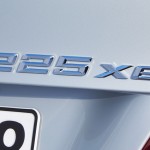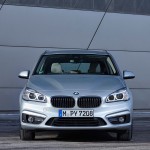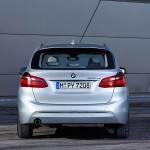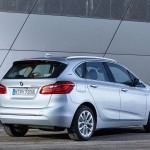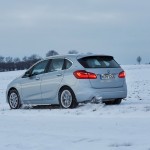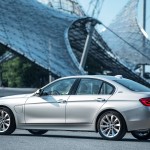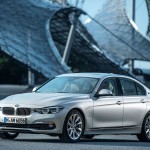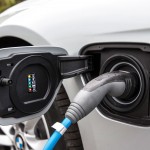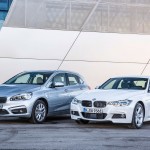The new BMW X5 xDrive40e was the first Plug-in Hybrid Electric Vehicle production car from the BMW core brand, not from fledgling BMW i. BMW marks its 100th anniversary this year and the announcements for plug-in hybrid vehicles are coming thick and fast. BMW will offer an additional four PHEVs to broaden the opportunity to drive ultra-low emission vehicles with all electric drive capability, bringing a total of five BMW branded PHEVs to market before the year’s end.
The four new PHEV models, indebted to the BMW i brand for technology – but not name – come in the shape of the BMW 225xe Active Tourer, BMW 330e Saloon, and later this year the BMW 740e and 740Le xDrive from the marque’s flagship model that features such goodies as automatic driverless parking via the key-fob. These new models mean BMW will soon offer PHEV technology from compact models through to luxury-class cars in most of their product line-up.
BMW 225e Plug-in Hybrid
The soon to be launched BMW 225xe Active Tourer shares the BMW eDrive technology previously seen in the BMW X5 xDrive40e, which in turn inherits learnings from the BMW i8. This technology includes a number of cutting-edge plug-in hybrid components that have the potential to make significant contributions to reducing fuel consumption and emissions, depending upon how they are driven. In addition to this, the BMW 225xe also builds on the experience gained from the BMW i8 as it features xDrive technology, which forms the brands core all-wheel-drive handling tech.
Producing a total output of 224hp (a combination of the three-cylinder combustion engine with BMW TwinPower Turbo technology, 136hp and an electric motor developing 88hp). The combustion engine sends its power to the front wheels via a six-speed Steptronic transmission and produces a peak torque of 220Nm but under heavy acceleration from rest and for overtaking manoeuvres, the power from the two drive systems combines to gives a peak torque of up to 385Nm. Its combined official fuel consumption of 141.2mpg makes the 225e an inviting package.
The BMW 225xe arrives in BMW retailers from April 2016 and prices start at £32,545 OTR*.
BMW 330e Plug-in Hybrid
Perhaps more impressively, the new BMW 330e Saloon offers a combined fuel consumption of 148.7mpg and CO2 emissions of 44g/km. Its state-of-the-art plug-in hybrid technology combines a 184hp 2.0-litre petrol engine with a 65kW (88hp equivalent) electric motor. The combined output of 252hp and combined maximum torque of 420Nm give the BMW 330e Saloon a 0-62mph acceleration time of just 6.1 seconds and a top speed of 140mph; proving the credibility of plug-in hybrids in being able to offer both efficient yet brisk driving on demand.
The high-voltage lithium-ion battery is located underneath the boot and boasts efficient refrigerant cooling including a highly integrated low-temperature circuit. The battery has a total capacity of 7.6 kWh, which enables an all-electric of around 25 miles, which has often been touted as the ideal range to cover most short drives and average commutes.
The integration of the high-voltage battery in the compartment under the boot gives the BMW 330e Saloon a level load compartment floor, while use of the optional through-loading system with 40:20:40 split rear seat backrests remains unrestricted. Together with its boot capacity of 370 litres, the new BMW 330e therefore offers all the everyday practicality of a conventionally powered BMW 3 Series Saloon without compromise.
Similarly to the BMW 225xe, with the 330e Saloon there is a choice of three driving modes: AUTOeDRIVE, MAX eDRIVE and SAVE BATTERY. In AUTO eDRIVE the top electric speed is limited to 50mph and ensures the combustion engine and electric motor work together to optimum effect in all driving situations and this forms the default setting for the vehicle. In MAX eDRIVE mode the BMW 330e Saloon uses only electric power, drawing on the electric drive system’s full output and driving electrically is possible all the way up to a top speed of 75mph. SAVE BATTERY mode only uses the petrol combustion engine for driving and recharges the battery to be deliberately maintained – or increased again if the charge level has dropped below 50 percent. This energy can then be used for pure-electric driving but, as with all plug-in hybrids, this negates any benefit of having a plug-in, reduces fuel consumption significantly and is a bit like paying petrol prices for electricity.
The BMW 330e Saloon comes as standard with auxiliary heating and cooling (output: 5kW). This function can be activated by a button on the 330e’s remote key or can be pre-programmed for a specific departure time using either the iDrive operating system or via the BMW Remote smartphone app. The details are shown on the Control Display.
The BMW 330e Saloon is eligible for congestion charge exemption and is eligible for the Government’s Plug in Car Grant (PiCG) representing a significant saving on the purchase price. It is on sale now priced from £33,935 OTR* with the first customers getting their cars in April 2016.
BMW 740e and 740Le xDrive
Details about these models is yet to be announced, but the cars will feature similar setups to the X5 xDrive40e where the “40” compares to the equivalent performance as that from the regular “40” diesel 7-Series. As with the X5 and 225xe, the 740e and 740Le both feature BMW’s xDrive all-wheel-drive capability. The electric motor will be housed between the engine and gearbox, which keeps the constant four-wheel drive mechanicals of their regular AWD cars.
BMW’s Hydrogen Future?
With all the buzz around hydrogen fuel cell vehicles, BMW has continued to produce prototypes incorporating new fuel cell technology with their eDrive electric motors and standard vehicle platforms. Examples include the 5-Series GT, that housed the hydrogen tank in what would typically have been the transmission tunnel to offer it both crash protection and a suitable location to house a large gas bottle. Their approach so far has mainly been to regard FCVs as a performance oriented package, which is perhaps an obvious choice for BMW to maintain their sport and prestige branding.
The brand first experimented with hydrogen 40 years ago and believes fuel cells offer a considerably smaller package than battery electric vehicles with several plusses, predominantly fill up time and range.
BMW will continue to develop these hydrogen-powered vehicles with a view to an application that might make series production in the future.
Source; BMW
